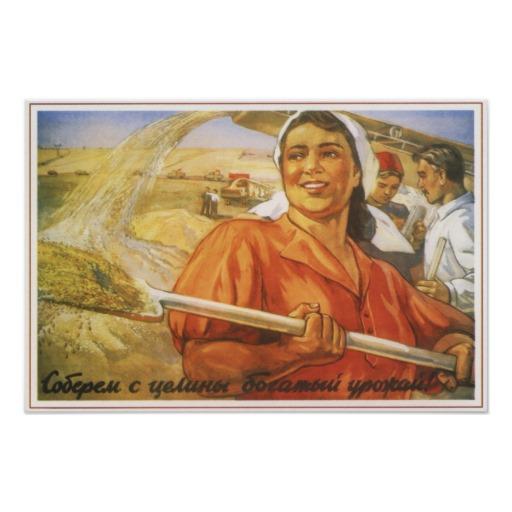Q: Did life improve under Stalin?
Source A: A poem published in ‘Pravda’ (a Soviet government-controlled newspaper), 1936.
O great Stalin, O leader of the people,
Thou who broughtest men to birth.
Thou who makes fruitful the earth,
Thou who restores the centuries,
Thou who makest bloom the spring,
Thou who makest vibrate the musical chords.
Thou splendour of my spring, oh thou
Sun reflected by millions of hearts.
Source B: This picture shows the booming impact of rapid industrialisation. Heavy industries like coal, steel, oil and electricity were built.
Source C: 6 Million perish in Soviet Famine partly due to collectivisation. This article is from Chicago, USA, a supporter of democratic leadership.
Source D: The Smoke of the Chimneys is the breath of the Soviet Union.
Source E: Let Us Fulfill Stalin's New Five-Year Plan!
Source F:A Soviet poster portrays the harvest from collectivisation. .http://rlv.zcache.com/ussr_soviet_union_1934_collective_farming_posters-r593932884cfb40ee482e01be143f3ea_v5kej_8byvr_1024.jpg
Source G: A Soviet poster portrays the harvest from collectivisation.
Source H : A poster that says “Do not gossip”!
Source I : A camp in Siberia for political dissidents.
Source J : This poster shows that the farming discipline needs to be tightened.
Adopted from History of the Second World War, Vol.IV : The Hinge of Fate, Winston Churchill.
Source K : This is a conversation between Winston Churchill and Joseph Stalin.
Book Titled : Working with Evidence 2, The Modern World – Peter and Mary Speed , book location MJR LIBRARY 904-909 Pg 71
“After he has talked it over with them he always answers that he does not want the Collective Farms and he would rather do without the tractors.’
“These were what you call Kulaks?”
“Yes” He said, but he did not repeat the word. After a pause, It was all very bad and difficult – but necessary.’
‘What happened?’ I asked.
‘Oh Well.’ He said. ‘Many of them agreed to come in with us. Some of them were given land of their own to cultivate in the province of Tomsk or the province of Irkutsk or farther North, but the great bulk were very unpopular and wiped out by their labourers.’
Source L: Adopted from the book “GCSE Modern World History, second edition – Ben Walsh”
MJR LIBRARY 904-909 Pg 131
“By the late 1930s many Soviet Workers had improved their conditions by acquiring well-paid skilled jobs and earning bonuses for meeting targets. Unemployment was almost non-existent. In 1940 the USSR had more doctors per head of population than Britain. Education became free and compulsory for all and Stalin invested huge sums in training schemes based in colleges and in the work place.
But, on the other hand, life was very harsh under Stalin. Factory discipline was strict and punishments were severe. Lateness or absences were punished by sacking, and that often meant losing your flat or house as well. To escape the hard work and hard discipline, some workers tried to move to other jobs, so the secret police introduced internal passports which prevented free movement of workers inside the USSR.”
Source M: Adopted from Historan E Roberts, Stalin, Man of Steel, published in 1986.
Book : GCSE Modern world history Second edition, Ben Walsh Pg 133
“Stalin, ignoring the great cost in human life and misery, claimed that collectivisation was a success; for, after the great famines caused at the time… no more famines came to haunt the Russian people. The collective farms, despite their inefficiencies, did grow more food than the tiny, privately owned holdings had done. For example, 30 to 40 million tons of grain were produced every year. Collectivisation also meant the introduction of machines into the countryside. Now 2 million previously backward peasants learned how to drive a tractor. New methods of farming were taught by agricultural experts. The countryside was transformed.”
["In the midst of the new and visionary I found an inefficiency that could drive one to desperation. I suppose it's because they've had to be so hurriedly trained and have no experience, and centuries of apathy to overcome, and perhaps just because they can get jobs whether they're good or not. But it takes days to get anything done. They never make an appointment, they tell you to come and then they'll arrange when you must telephone again to ask for an appointment. Lifts are always out of order; a current anecdote has a 'lift factory' entirely devoted to manufacture of the notices LIFT OUT OF ORDER".]
[“I was going to be one of the many who cared not to own a second pair of shoes, but who built the blast furnaces which were their aim. I would wager that Russia’s battle of ferrous metallurgy alone involved more casualties than the battle of the Marne. All during the thirties the Russian people were at war. . . In Magnitogorsk I was precipitated into a battle. I was deployed on the iron and steel front. Tens of thousands of people were enduring the most intense hardships in order to build blast furnaces, and many of them did it willingly, with boundless enthusiasm, which infected me from the day of my arrival.”]
Source P: This statistics shows the GDP per head increase in USSR, compared to Latin America after the implementation of collectivisation and rapid industrialisation.
Source Q: This picture shows the expectation and reality of Stalin’s 5-year plan from 1927-1937.
Adopted from the book “GCSE Modern World History, second edition – Ben Walsh”
MJR LIBRARY 904-909 Pg 129
No comments:
Post a Comment